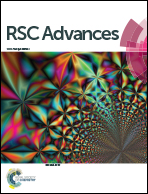Highly stable low temperature alcohol sensor based on hydrothermally grown tetragonal titania nanorods
Abstract
Highly stable, low temperature (27–175 °C) alcohol (ethanol, methanol and 2-propanol) sensing performance of a hydrothermally grown tetragonal TiO2 nanorod array, targeting the detection level of 1–100 ppm, is reported in this paper. Synthesized titania nanorods were characterized by X-ray diffraction, energy dispersive spectroscopy (EDS) and field emission scanning electron microscopy (FESEM) to investigate the crystallinity, chemical compositions and surface morphology, respectively. Photoluminescence spectroscopy (PL spectra) was employed to find out the surface oxygen vacancies and band gap of the material. An alcohol sensing study, in resistive mode, was carried out and the optimum temperature for alcohol sensing was found to be 75 °C with the corresponding maximum response magnitude of ∼69%, ∼75% and ∼80% towards 100 ppm ethanol, methanol and 2-propanol, with corresponding response time/recovery time of ∼13 s/24 s, ∼11/21 s and ∼9/18 s, respectively. The sensor also offered efficient detection (response magnitude of 29%, 37% and 40%) of 1 ppm alcohol(s) with fast response time and recovery time of ∼12–14 s and ∼4–5 s, respectively. The minimal cross sensitivity, with other interfering species like acetone, benzene, xylene and 2-butanone, and appreciable long term stability showed the potential of the developed sensor for commercial applications.


 Please wait while we load your content...
Please wait while we load your content...